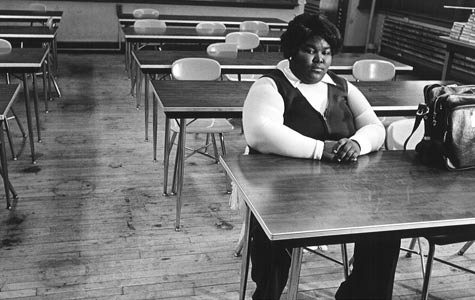The crowd is in a frenzy now, and will remain so as six more buses pull up, most of them nearly empty, during the next 20 minutes. The first small group of kids enter the building without incident, as the photographers dash after them, and a second bus comes almost immediately. Moments after the second group of black kids gets safely into the building, the first violence erupts.
Three pickets from the Progressive Workers Party are standing at the curb near the fringe of the crowd, holding signs urging them to "fight racism, not busing" One of the pickets is black; suddenly, as the crowd roars its approval, he disappears in a sea of moving bodies. Police move in momentarily to drag him to safety across the street.
The crowd grows more enthusiastic. They break into the school song ("For Boston, for Boston, the high school on the hill") and when they tire of that, they switch to chants borrowed from last year's football season ("Here we go, Southie, here we go").
It is getting ugly now and the police know it. At 8:07 a line of police reinforcements moves down G Street and fans out facing the crowd.
Two minutes later the first object-- a rock -- is thrown as another bus moves in. Seconds later a bottle comes flying out of the crowd and finally, when the next bus arrives after a delay of several minutes and is met with a barrage of chunks of wood, the police move.
After reportedly issuing an order to disperse (this reporter, in the midst of the crowd, heard no such order), the cops bunch up near the front of the school and push outward, driving the crowd on the sidewalk down the G Street hill. For a few seconds it is brutal: some kids resist, the cops get tough, and there is pushing and shoving in both directions.
Finally all movement is in one direction — down the hill — quickly.
The crowd seems momentarily stunned, as if they had never expected that kind of sweeping police action.
"Can you imagine," says one woman who asked not to be identified, "can you imagine them chasing the kids down the hill like that, even grabbing hold of the girls. Who are they working for, anyway?"
But after a while, the kids all drift back up the hill, in twos and in threes. Their return is a signal that it is not over, that they are ready for more action if given half a chance.
***

Photo: Ken Kobré
Economic geography: A classroom in South Boston High School on the first day of school with only one black student in attendance. Picture taken September 12, 1974.
|
From that point until shortly before the school's 2 o'clock closing, the prevailing mood was that of a summer carnival, complete with guest appearances by Chester Broderick, head of the policeman's union, by Southie representative Ray Flynn, and by the city's best-known busing opponent, City Councillor Louise Day Hicks ("The people have shown great restraint," said Mrs. Hicks).
But the surface mood was deceptive, and violence erupted several times. A black teacher who appeared outside the school became the target of tomatoes and bottles and a TV cameraman was roughed up, apparently when he bumped into someone in the crowd.